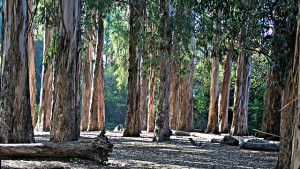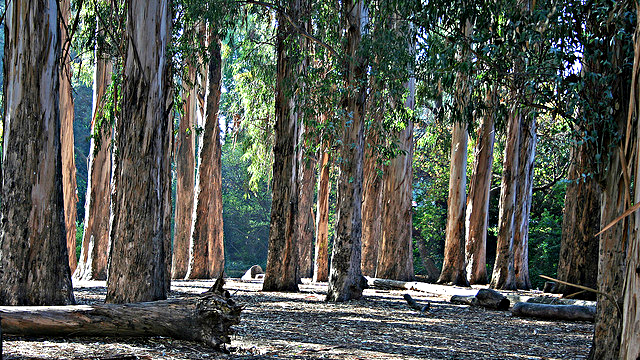
Twenty years ago this week, a fire ripped through the Oakland and Berkeley hills, taking 25 lives and burning more than 3,000 homes. Eucalyptus trees, leaf litter, and long peels of bark were fuel for the fire. The Park Service estimates that eucalyptus was responsible for 70% of the energy released though combustion of vegetation. The trees, leaves, and bark are packed with phenolic compounds that burn hot, and the trees’ tall stature, proximity to homes, and long, swaying branches helped propagate the fire. To minimize future fires, the Park Service and others call for the removal of eucalyptus leaf litter and even whole trees—which is expensive and sometimes controversial.
Eucalyptus trees are relatively new to California. Originally from Australia, the species most common in the Bay Area, Eucalyptus globulus, or blue gum, was planted in the 1850s following the gold rush, with the hope that the timber could be used for railroad ties. Old-growth eucalyptus forests in Australia provided excellent timber. But while eucalyptus grew quickly in California, the young trees made awful timber. The wood twisted and split as it dried. So eucalyptus trees were instead used as windbreaks, to mark property boundaries, and to prevent erosion.
The trees quickly spread. Eucalyptus grow like crazy in the California climate, growing much taller than they do in their native Australia. Once eucalyptus become established, they can take over. Their Australian competitors did not come to California with them. Their dense canopy blocks light from entering the understory. As the fallen leaves decompose, they make the soil more acidic, and other plants can’t grow there. In California, eucalyptus often form a monoculture, devoid of other species. And the trees take up huge amounts of water. In some areas of the world, people planted eucalyptus to drain swamps and reduce the habitat for mosquito larvae, thereby eradicating malaria.
The blue gum eucalyptus evolved in a fire-prone environment, and the species has many fire adaptations. Their seeds are extremely resistant to heat. After a fire, trees that are relatively intact will quickly drop their seeds. And trees that have burned can re-sprout from their stumps and root systems.
To prevent eucalyptus from fueling future fires, the bark peelings and leaves need to be removed from the understory. A study conducted in the 1970s estimated 10-40% of the leaves that fall each year decompose in that year; fuel builds up quickly. Sometimes, entire trees need to be removed. After the 1991 fire, approximately 400 acres of eucalyptus were removed from the East Bay Regional Park District. Removing trees is even more difficult and expensive than removing litter, as the trees are huge and they re-sprout from the stump. To prevent re-sprouting, stumps need to be treated with chemical herbicides or covered in sheets of black plastic, so sunlight does not reach them. Another option is to topple the trees—knock them over so their roots are torn up from the ground. In addition to being a lot of work, removing trees is often controversial; neighbors don’t like it. Several large eucalyptus trees were recently removed from a Department of Motor Vehicles property in Oakland, resulting in neighborhood outrage.
